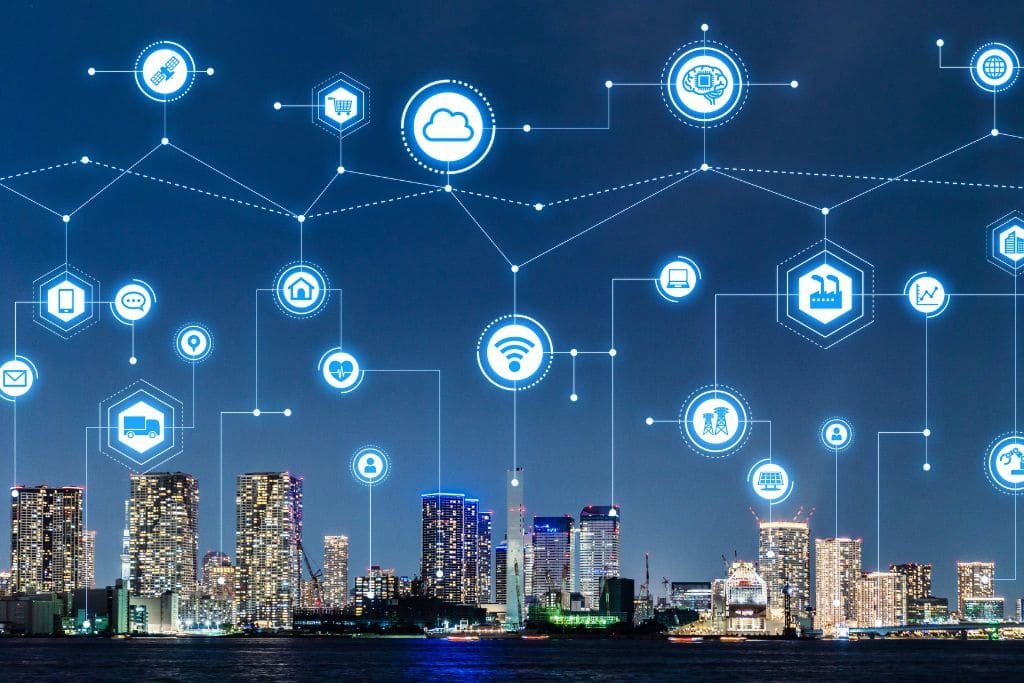
Building Connected and Efficient Urban Landscapes Smart cities technology stands out as a transformative force in the quest for sustainable urban development and improved quality of life. By utilizing the Web of Things (IoT), computerized reasoning (man-made intelligence), huge information investigation, and other advanced developments, urban communities all over the planet are turning out to be more associated, productive, and versatile. Urban areas can use these technologies to get the most out of their resources, improve public services, and deal with the growing problems caused by urbanization, environmental sustainability, and economic growth.
Advanced digital infrastructures that collect, analyze, and manage data from a variety of sources, such as sensors, cameras, mobile devices, and other Internet of Things (IoT) devices, are at the heart of smart cities. This data-driven strategy makes it easier to make well-informed decisions and manage city resources and services effectively.
(IoT) and other key technologies that make smart cities possible: IoT gadgets give continuous information on different parts of the metropolitan climate, from traffic conditions to air quality, empowering responsive and versatile city the executives.
Man-made brainpower (artificial intelligence) and AI (ML): Computer based intelligence and ML investigate immense measures of information to anticipate patterns, upgrade activities, and mechanize dynamic cycles, making urban communities more astute and responsive.
Large Information Analytics: The capacity to process and examine enormous datasets permits urban areas to reveal bits of knowledge and examples, illuminating strategy and independent direction.
5G Connectivity: Real-time responses and connectivity are made possible by high-speed, low-latency 5G networks. These networks facilitate the rapid transmission of data between central systems and devices.
Brilliant urban communities innovation is altering different parts of metropolitan living, making urban communities more reasonable, manageable, and effective.
Shrewd networks and savvy meters in energy and water frameworks enhance utilization and diminish squander, adding to maintainability and cost reserve funds. Insightful lighting frameworks change in view of ongoing circumstances, upgrading wellbeing while at the same time limiting energy use.
Computerized stages and applications furnish inhabitants with continuous data on open transportation, stopping, and local area occasions, further developing availability and personal satisfaction. E-administration drives smooth out processes, making city benefits more available and proficient.
AI- and IoT-powered traffic management systems improve traffic flow and reduce congestion. Savvy public transportation frameworks offer continuous following and booking, improving productivity and rider experience. Charging stations for electric vehicles (EVs) aid in the transition to sustainable transportation.
Technologies like predictive policing and video surveillance increase urban safety by assisting in the prevention of crime and enhancing emergency response capabilities. Debacle the executives frameworks use sensors and simulated intelligence to foresee and answer catastrophic events, limiting gamble and harm.
Smart cities use IoT sensors to monitor the quality of the air and water, allowing for proactive environmental management. Squander the board frameworks enhance assortment courses and timetables, diminishing discharges and further developing reusing rates.
Although smart cities have enormous potential, implementing them can be challenging. Protection and security concerns top the rundown, as the assortment and examination of information present dangers to individual privileges and opportunities. Guaranteeing fair admittance to the advantages of savvy urban communities innovation is additionally significant to abstain from compounding existing disparities. Moreover, the reconciliation of new advancements requires huge venture and coordination among different partners, including government organizations, innovation suppliers, and residents.
The concept of intelligent, fully integrated urban ecosystems is becoming increasingly feasible as technology advances. The development of smart cities, which offer solutions to some of the most pressing urban issues, will continue to be driven by advancements in AI, the Internet of Things, and connectivity. Smart cities have the potential to transform urban landscapes into thriving, resilient communities for future generations by encouraging collaboration and placing an emphasis on sustainability and inclusivity.
Smart city technology aims to create environments that are more livable, efficient, and sustainable in addition to digitalizing urban spaces. As urban communities keep on developing, utilizing innovation to upgrade the personal satisfaction while limiting natural effect will be principal. The excursion towards savvy urban communities is a cooperative undertaking, requiring the responsibility, everything being equal, to understand the maximum capacity of this thrilling vision.